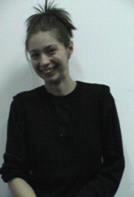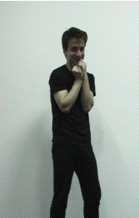Abstract
The present paper aims at studying the student actors’ ability to express their emotional experiences by analysing their expressions based on partially directed improvisation. The study uses an applicative approach which helps discover and stimulate the student actors during the practical courses. The expressions were caught on camera. In analysing the data, we used the judging method. By means of this type of evaluation, we intended to analyse the subjects’ capacity to communicate their emotions; their expressiveness and the number of combinations proposed for each expression separately. If there is a hereditary creative potential (minimum average level), that is influenced by education, then we can introduce corrective technical elements and exercises meant to improve the subject’s creativity (in terms of fluency, flexibility and inner development) and to develop their capacity of expression. Imaginary emotional experience involves maintaining a certain amount of control, therefore such an experience is never lived to the capacity and primary intensity of a real-life emotion. The ability of expression is revealed by achieving a satisfying average between the expressiveness evaluation and the evaluation of the internal elaboration of the expressions.
Keywords: Emotional feelingsemotional expressionexpression
Introduction
Pope John Paul II said: He who creates bestows being itself, takes something out of nothing - ex nihilo sui et subiecti - and this, in a narrow sense, is only the Almighty’s own way. However, the artist uses some of what already exists, giving it form and meaning. (John Paul II, 2003) Therefore, the ability of scenic expression is given by the value of the expression, which depends on the accuracy and quality of the internal experience of emotions. So, the ability of scenic expression is an attribute and a way to create and send a message. Ion Luca Caragiale said: The dramatist is an instrumental performer whose instrument is his own material being. (Petrescu, 2014)
Problem Statement
During this study, the student actors were asked to produce expressions, using their entire body while having the freedom to create the situations which induced them the emotional states and eventually generated those expressions. This way, the impromptu was guided only partially, hence the students had the opportunity to capitalize on their strengths.
Research Questions
If there is a creative hereditary potential (minimum average level) and if the subject is influenced by education, then we can introduce corrective technical elements and exercises meant to improve the subject’s creativity (i.e. fluency, flexibility and inner development) and, thus, to develop their capacity of expression. The study uses an applicative approach which helps discover and stimulate the student actors during the practical courses.
Purpose of the Study
The study was conducted on 2nd year students enrolled for the Performing Arts programme (Footlights). Twenty-four subjects were tested. The expressions were caught on camera. The evaluation covered:
- The communication level of the expressions – the photos are selected in so far as the expressions displayed are easily recognisable or not;
- The expressiveness level – the expressions are or are not valuable from an artistic perspective;
- The number of combinations each student proposed for each expression separately.
The photos were evaluated by three competent evaluators (using a rating scale with grades from 1 to 10); The 10-point grading scale served as a means to classify expressions in point of their value and evaluate expressiveness. In assessing the expressions the evaluators referred to the scenic expression models in the field. Therefore, the expressions most accurately communicated were marked with 10, the simple expressions lacking artistic value were marked with 5, while 1 was awarded for the refusal of the subjects to perform the task given. The intermediate grades reflected the differences between the subjects. The resulting grades were processed as averages, which became the subjects’ performance indicators.
Research Methods
The proposed expressions were:
Simple expressions: joy and fury;
Complex expressions: hypocrisy and love.
We provide below some expression examples (caught on camera), as well as the interpretation given by the subjects to the situations that generated such expressions:
JOY



A B. C.



D. E. F.
Circumstances that generated joy:
A. I was playing with my kitten.
B. I’m coming home (this happens rarely) and I see my mother and my grandmother again.
C. God, how many foolish things I was able to write!
D. I am reading a message from my friend, which makes me happy.
E. The umbrella trees have bloomed in Cismigiu Gardens which means spring has come and I feel very happy.
F. I’m talking with my friends and I’m laughing very loud when we remember how we used to lark in college.
The expression of joy is characterised by the subjects’ smile or laughter, accompanied by wide gestures, a relaxed body, raised lip corners and (swallow-shaped) wrinkled eyelids. The facial expression is mainly driven by the 14 synergistic and anatomically connected muscles located at the centre of the face (Ghitescu, 2013).
The tested subjects generally showed an exuberant, active, strong joy. This form of expressing joy, involving active reactions, is the most common. Careful observation revealed a more active blood flow accompanied by increased blood pressure and peripheral vasodilatation resulting in blush and bright, glowing eyes (the lachrymal secretion is also increased).
FURY



A. B. C.



D. E. F.
Circumstances that generated fury:
A. I have lost a job at an entertaining company because my boyfriend gave negative feedback to the company, using my e-mail address, and his word has been taken into account.
B. I remembered something unpleasant.
C. I am furious because my colleagues have told me I never look good.
D. I’m arguing with a good friend and I am deeply affected because she doesn’t want to consider my advice.
E. I'm very nervous because my opinion is disregarded.
F. I’ve just found out my boyfriend is cheating on me.
The subjects’ attitude shows an increase in muscle tone, accompanied by the pointing of the head and eyes towards the fact / thing / person that caused the emotional state (Sterpetti, 2016). The body muscle contraction is static, resulting in the attenuation of motor manifestations, sometimes up to the point of rendering the body immobile (Nenciu, 2014). Besides muscle strain, fury is expressed by frown eyebrows and mouth and hand gestures that clearly show that one should beware of the angry person. Reflex inhibition phenomena occur due to emotional shock and become particularly evident at the level of the face (fixity of eyes/look, frown, flushing), and through a rigid body attitude (Von Bekesy, 2017). In the tested subjects, fury was expressed in the form of rebellion, leading to an aggressive behaviour or to motor reactions of protest or reproach.
HYPOCRISY:




A. B. C. D.
The situation described by the subject: I am at the
A. I pretend to be surprised by the teacher’s indication, which in my opinion is an ineptitude;
B. I do not want to follow the indication and therefore I pretend I don’t understand what I’m being told;
C. I’m trying to leave the impression that I agree with what the teacher says;
D. I am not going to do anything my teacher asked me to.
Hypocrisy is expressed especially by mimics and gestures. It involves dissimulation and duplicity and results in miming surprise, benevolence or understanding (Ghitescu, 2013). In is in fact contempt mixed with disgust, showed by lifting the corner of the mouth and through mimics denoting falsity.
LOVE:




A. B. C. D.
The situation was described by the subjects as follows:
The basic theme: I’ve seen her, she must be mine!
She is very pretty and I like her.
I must find a way to be noticed by her.
This hasn’t worked too much.
It’s not the end of the world, I’ll try again.
As love is a complex feeling, experienced only in relation to another person, this was the hardest task for the participants to the study. Involving a series of personal and emotional experiences that have proved to be very different from subject to subject, love is expressed in extremely various ways: from melancholy to dreaming, from joy to sadness, from exuberance to apathy (Ting-Toomey, 2015).
Findings
In evaluating the expressions we analysed the connection between the scenarios proposed by the subjects and the resulting expressions performed by bodily movements, mime and pantomime and gestures the subjects induced through motivational impulses and emotional states and processes. The results are summarized in table
Item 1 Joy – the arithmetic mean of the average values is 7.62. The maximum average value is 9.33 and the minimum average value is 4.33. The amplitude of the average values is 5.00 units.
Item 2 Fury – the arithmetic mean of the average values is 7.94. The maximum average value is 10, while the minimum average value is 5.00. The range of the average group values is 5.00 units.
A comparative analysis of the two simple emotions (joy and fury) reveals that the group simulating fury outscored the one simulating joy (7.94, as compared to 7.62). We can say that most of the simple expressions were communicated in an ordinary, static way and were relatively neutral (with no real involvement from the subjects). This outlined the difficulty in finding complexity in simplicity. The simulated simple expressions group shows the limits of the process of identifying the emotions by the evaluators, on the one hand, and the limits of the subjects’ capacity of expression and of their expressiveness, on the other hand.
Item 3 Hypocrisy - the arithmetic mean of the average values is 7.65. The maximum average value is 9.67 and the minimum average value is 5.00. The amplitude of the average values is 4.67 units.
Item 4 Love – the arithmetic mean of the average values is 7.38. The maximum average value is 9.67, while the minimum average value is 4.67. The amplitude of the average values is 5.00 units.
If we compare the complex emotions, we can notice that the values recorded are very close. However, the Hypocrisy group scored higher than the Love group (7.65, as compared to 7.38). The close values recorded by the two complex emotions groups reflect the correspondence between the expression displayed and its internal elaboration, namely the relation between the subject’s capacity to transpose themselves (as an information processing internal laboratory) and their scenic expression ability (the visible form of the project).
Conclusion
We must take into consideration the fact that the actors’ emotional experience is an imaginary experience, a fictional one, which involves maintaining a certain control (Constantinescu & Pepino, 2016). Thus, it is neither being nor ever lived to the capacity and primary intensity of a real-life emotion.
There is a slight difference between the two basic emotions – joy and fury – in terms of the values recorded (7.94 – fury, as compared to 7.62 – joy). The results for Item 1 – Joy reveal that more than half of the subjects (18 out of 24) tested above the average value of the group.
The capacity of expression was approached from the perspective of conveying the message elaborated by falling into a particular emotional state. The emotions were communicated by corporeal mime. The evaluators assessed the capacity of the subjects to convey the intended meaning by means of the expressions produced, on the one hand, and the scenic expressions in relation to their appropriate internal elaboration.
The procedures of identifying and evaluating the emotions cannot reveal the individual differences in terms of expressiveness as differences in aptitude. This indicates the need to design tailor-made teaching techniques to stimulate expressiveness.
As in the case of the simple emotions, there’s a slight difference between the values recorded by the complex emotions groups as well (7.65 – hypocrisy / 7.38 – love). The participants scoring around the average group value reveals a certain mental structure. Therefore, we notice a shift in thinking from the abstract zone to the intuition zone mainly characterised by plastic, concrete representations. Hence, complex emotions are the acquisitions of learning and education.
Based on the results recorded, we believe that the student actors may develop the capacity of expression and increase their expressiveness if the training programmes are adapted to their evolution. To this end, new exercises, designed for various purposes, can be introduced according to the students’ mental and physical particularities and to the curriculum.
An important aspect of the study is the fact that the original mental elaborations had an affective nature, which shows us that there is a complex of emotional attitudes of each subject towards the imagined items, and they are combined in a relationship in which the subject takes on the role of the interpreter (Kantor, 2014). On the other hand, the capacity of expression, as a specific indicator of the scenic talent, is revealed by achieving a satisfying average between the expressiveness evaluation and the evaluation of the internal elaboration of the expressions. (Mocanu, 2014).
In conclusion, we can say that the expressive bahaviour, including also nonverbal communication, is a current interest concern in the scientific community. For the student actors, the expressive behaviour is a prerequisite in their profession.
As Pope John Paul II said: Searching for the truth is the responsibility of hard sciences. The researcher that is in the front line of science feels all the beauty of St. Augustine’s words – Love the intellect strongly – Intellectum valde ama - and the role he has in knowing the truth (Macchetto, 2014).
References
- Constantinescu, T., Pepino, C. (2016) A fi artist inseamna in primul rand a fi liber. Journal Colocvii teatrale, Issue 21, 83-96 https://www.ceeol.com/search/article-detail?id=427585 [accessed Jun 17, 2017]
- Ghiţescu, Gh. (2013) Anatomia artistică.vol. III, Morfologia artistică. Expresia, Iaşi: Editura Polirom, 94 139.
- Kantor, T. (2014) Scrieri despre teatru. Bucharest: Editura Fundatia Culturala Camil Petrescu, 56-84.
- Mocanu, A. (2014) Avram Goldfaden şi teatrul ca identitate. Bucharest: Editura Fundatia Culturala Camil Petrescu, 42-48.
- Nenciu, G. (2014). Biomecanica. Bucharest: Editura Fundatiei Romania de Maine, 45-61.
- Macchetto, D. (2014). A Pioneering Pontificate: Reflections from a Scientist. Interdisciplinary Encyclopedia of Religion and Science. http://inters.org/duccio-macchetto-john-paul-ii-canonization [accessed Jun 16, 2017]
- Papa Ioan Paul al II-lea (2003) Cugetări.Bucharest: Editura Fundatiei Romania de Maine, 109.
- Petrescu, C. (2014) Cetatea literară. Bucharest: Editura Fundatia Culturala Camil Petrescu, 31.
- Sterpetti, A. (2016) Anatomy and physiology by Leonardo: The hidden revolution? Journal Surgery, volume 159, Issue 3, 675-687
- http://www.surgjournal.com/article/S0039-6060(15)00828-4/abstract [accessed Jun 17, 2017]
- Ting-Toomey, S. (2015) Identity Negotiation Theory. The International Encyclopedia of Interpersonal Communication..http://onlinelibrary.wiley.com/doi/10.1002/9781118540190.wbeic129/abstract;jsessionid=47A3A98E6F0E9F7D422D8288F6177506.f04t03?userIsAuthenticated=false&deniedAccessCustomisedMessage= [accessed Jun 16, 2017]
- Von Bekesy, G. (2017) Sensory Inhibition. New Jersey: Princeton University Press, 182-192. https://books.google.ro/books?hl=ro&lr=&id=rIYrDgAAQBAJ&oi=fnd&pg=PP1&dq=Reflex+inhibition+phenomena+on+face&ots=DZdLdL44n1&sig=N4_fmg5hZ_LmRiOJlouDF7rGkHc&redir_esc=y#v=onepage&q&f=false [accessed Jun 16, 2017]
Copyright information

This work is licensed under a Creative Commons Attribution-NonCommercial-NoDerivatives 4.0 International License.
About this article
Publication Date
29 November 2017
Article Doi
eBook ISBN
978-1-80296-031-0
Publisher
Future Academy
Volume
32
Print ISBN (optional)
-
Edition Number
1st Edition
Pages
1-200
Subjects
Sociolinguistics, linguistics, family psychology, child psychology, developmental psychology
Cite this article as:
Iorga, A. (2017). Emotional Experiences Of The Student Actor Identifying Simple And Complex Emotional Expressions. In Z. Bekirogullari, M. Y. Minas, & R. X. Thambusamy (Eds.), Cognitive - Social, and Behavioural Sciences - icCSBs 2017, October, vol 32. European Proceedings of Social and Behavioural Sciences (pp. 102-110). Future Academy. https://doi.org/10.15405/epsbs.2017.11.10

